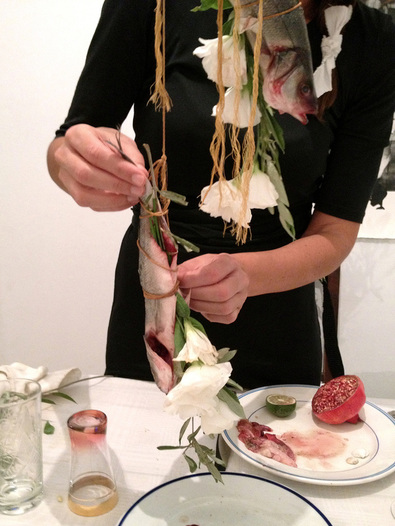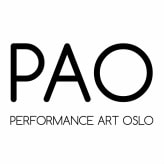Interview with Augusta Atla
 Tree of life, performance by Augusta Atla at Remap art festival, Athens, GR, 2013
Tree of life, performance by Augusta Atla at Remap art festival, Athens, GR, 2013
ATHENS, GREECE, 19 OCT 2015
Q: Why / when / how did you start to work with performance, what is your background, how did you arrive at doing performance?
I started performing in 2005 during my art education in London. I was searching for a platform where I could experiment with reality and with the interpretation of reality together with the interaction of the audience. I did public performances in the streets of London and also my photography, installation and sculpture work was a means to develop ways of ‘recording the presence and time of the artists body’.
Q: What is your process like when you make a performance, from idea to actual work?
I work intuitively without any plan, listening to the irrational darkness of my emotions and interpretations of impressions - and strangely it always comes together beautifully without intentionally making something coherent.
Q: Can you tell about your latest project?
Helios or a poem from Athens was a performance Nikos Branidis and I did in Copenhagen, DK at Banja Rathnov Gallery in October 2015. We intuitively sampled images, poetry, sound, objects and gestures with references to Athens as well as the photographic darkroom lab, the kitchen, the sculptor's workplace, found photography, ink in colors and herbs used as a rituals. All these elements created a metaphor of the ‘Artist's Cave’- a hiding place in the world where we have made sacred the process of emotionally digesting contemporary politics and reality.
Q: What role does performance art have in your life / artistic praxis? Do you also work within other fields, like installation, sculpture, drawing, other expressions? How do they influence / inform each other?
I work in all media- photo, sculpture, painting, print, installation and so on. I understand the traditions of a media, but I bend and treat the media as I want it. Performance work is related to all my other endeavours in art and vice versa - simply because for me the artist at work, expressions of Time is the core of my practice, in whatever i do.
Q: With what kind of form / material do you express yourself and use in your work and how did you arrive at using this material?
I have no rules for what materials to use or why- I am open to anything.
Q: How do you experience or consider the audience / surrounding. What space / surrounding do you find interesting to work in. How does your surrounding influence your work. Do you involve the public? If so how?
During a performance work, I do not engage the audience directly, but indirectly as a form of presence which is why I love performance. Performance is a shared experience in a space and can make us process emotions together. Shared emotional intelligence is very important for humanity to keep developing and learning.
Q: Can performance art be taught, and why would it have educational purpose ?
Yes, performance art can be taught, it has a history going back to Greek Ancient mythology, ritual and Ancient theatre. In the 20th century, performance art was developed through DADA, Futurism, Bauhaus and painting, slowly developing itself into contemporary performance art as we know it from the 60's in NYC and Europe. Performance art intersects with painting, perhaps even arrives from painting in a formal consciousness of the artist’s body as an instrument (ref. Pollock and Frankenthaler). Yes, performance art has an educational purpose, since it can historically describe cultural aspects of our Western society, it can theoretically and formally make us debate and further develop mediums of art - and most importantly it can develop an emotional awareness and give ways to process irrational feelings freely as well as emotional aspects inside us that are difficult to measure or express.
<< Back
Q: Why / when / how did you start to work with performance, what is your background, how did you arrive at doing performance?
I started performing in 2005 during my art education in London. I was searching for a platform where I could experiment with reality and with the interpretation of reality together with the interaction of the audience. I did public performances in the streets of London and also my photography, installation and sculpture work was a means to develop ways of ‘recording the presence and time of the artists body’.
Q: What is your process like when you make a performance, from idea to actual work?
I work intuitively without any plan, listening to the irrational darkness of my emotions and interpretations of impressions - and strangely it always comes together beautifully without intentionally making something coherent.
Q: Can you tell about your latest project?
Helios or a poem from Athens was a performance Nikos Branidis and I did in Copenhagen, DK at Banja Rathnov Gallery in October 2015. We intuitively sampled images, poetry, sound, objects and gestures with references to Athens as well as the photographic darkroom lab, the kitchen, the sculptor's workplace, found photography, ink in colors and herbs used as a rituals. All these elements created a metaphor of the ‘Artist's Cave’- a hiding place in the world where we have made sacred the process of emotionally digesting contemporary politics and reality.
Q: What role does performance art have in your life / artistic praxis? Do you also work within other fields, like installation, sculpture, drawing, other expressions? How do they influence / inform each other?
I work in all media- photo, sculpture, painting, print, installation and so on. I understand the traditions of a media, but I bend and treat the media as I want it. Performance work is related to all my other endeavours in art and vice versa - simply because for me the artist at work, expressions of Time is the core of my practice, in whatever i do.
Q: With what kind of form / material do you express yourself and use in your work and how did you arrive at using this material?
I have no rules for what materials to use or why- I am open to anything.
Q: How do you experience or consider the audience / surrounding. What space / surrounding do you find interesting to work in. How does your surrounding influence your work. Do you involve the public? If so how?
During a performance work, I do not engage the audience directly, but indirectly as a form of presence which is why I love performance. Performance is a shared experience in a space and can make us process emotions together. Shared emotional intelligence is very important for humanity to keep developing and learning.
Q: Can performance art be taught, and why would it have educational purpose ?
Yes, performance art can be taught, it has a history going back to Greek Ancient mythology, ritual and Ancient theatre. In the 20th century, performance art was developed through DADA, Futurism, Bauhaus and painting, slowly developing itself into contemporary performance art as we know it from the 60's in NYC and Europe. Performance art intersects with painting, perhaps even arrives from painting in a formal consciousness of the artist’s body as an instrument (ref. Pollock and Frankenthaler). Yes, performance art has an educational purpose, since it can historically describe cultural aspects of our Western society, it can theoretically and formally make us debate and further develop mediums of art - and most importantly it can develop an emotional awareness and give ways to process irrational feelings freely as well as emotional aspects inside us that are difficult to measure or express.
<< Back
